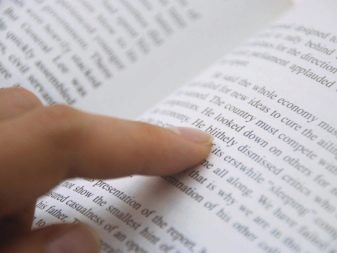Speed reading: what is it, what is it for and how to master this skill?

Time is one of the most important resources in the modern rhythm of life. More than once we had to hear from someone from our environment that time is sorely lacking, and we ourselves constantly feel this. Speed reading skills will help you to cope with the colossal flow of all kinds of information much faster and significantly save the most valuable resource - time.
On the Internet, there are many articles of exactly the opposite kind. Some argue that speed reading does not work, others cite a variety of examples of significant success. Let's try to understand the methods, working techniques and techniques for mastering useful speed reading skills.

What it is?
Speed reading is:
- a person's ability to quickly perceive textual information with a high level of perception using special reading methods;
- a set of skills for processing and high-quality assimilation of information;
- a useful tool for saving personal and work time;
- an effective tool for the development of intelligence and memory training.
Speed reading is not an end in itself. It is important to be able to understand the essence and meaning of the written text while reading quickly and confidently. Having mastered the technique of speed reading, you can increase the speed of perception by 3-4 times. If the average speed of a standard reading of an adult is considered to be 200-250 words per minute, then with speed reading it increases to 600-700 words.
Some experts note that with speed reading, the percentage of assimilation of the material in comparison with ordinary reading inevitably decreases.That is why the ability to isolate the main meaning from the text, to keep the material in memory and to filter out insignificant moments becomes especially relevant during speed reading.

Basic principles
When using the speed reading technique, two basic principles apply.
- Skimming. It is a visual search for sentences in the text to identify clues to the main question or to the purpose of reading. The beginning and end of the text are read, then the first sentence of each paragraph, to quickly determine if more detailed information is needed for a given question. It is a mistake to think that skimming is a random process, because for the efficiency of reading a structure is needed, what is more important is what is read, and not what is skipped.
- Scanning... It is the process of finding the information you need using a mind map formed from skimming. For a successful scan, it must be clear how the material is structured and what to read so that you can find the information you need. The scan includes the main thesis, headlines, facts, important pieces of information.
The components of the fast reading technique are special text processing techniques, search algorithms, text processing, wide text coverage at a glance.

Why is this needed?
There is no doubt that the modern rhythm of life is experiencing information overload. The amount of information is growing almost exponentially. How not to get lost in this rushing stream? Numerous sources of information - television, the Internet, brochures, magazines, popular science publications - everything is overflowing with information about changes in various technologies, about all kinds of news, about new trends in some processes. To remain successful, you need to have knowledge in competitive areas, respond quickly to changes in the situation, and be always “afloat”.
Of course, speed reading is not a panacea, but to a large extent it helps to "keep your finger on the pulse of the time." In addition, when reading speed, a person develops "bonuses" that create additional benefits in some aspects of life.
- Memory training. When reading speed, the human brain begins to work at a higher level. If classes for mastering the speed reading technique become a system, the perception and memorization of information is improved, memory is trained.
- Focusing attention. Speed reading methods allow you to fully concentrate on reading, not to be distracted by extraneous thoughts that are far from the material being read. As a result, attention is completely directed towards obtaining information from the text being read.
- Development of logical thinking. Reading is an exercise for the brain. Training the brain with speed reading helps to sort information more efficiently and form correct connections with previously stored fragments of knowledge. With an increase in reading speed, the inductance of thinking is automatically improved.

Benefit and harm
Historically known facts from the life of world famous personalities, albeit indirectly, are still an indicator that speed reading contributes to success and this is not a myth. Suffice it to say that our famous compatriots Maxim Gorky, Alexander Pushkin, Vladimir Lenin, as well as foreign leaders of various historical eras, knew how to read quickly - Napoleon Bonaparte, Theodore Roosevelt, John F. Kennedy, Karl Marx and many other famous personalities. It follows that mastering speed reading is worthwhile.
Speed reading is the only method in which mental activity is turned on simultaneously in both hemispheres of the brain. The development of the inductance of thinking and the speed of thought processes during speed reading will allow you to track the author's intention and quickly catch the structure of the text.
Despite the obvious advantages of speed reading, recognized by many of those who have mastered this technique, the debate around existing techniques continues today.There are many opponents who consider speed reading not at all as reading as such, but as viewing texts. For the most part, opponents point out one, but very significant disadvantage - the developed speed reading techniques do not allow to fully understand the meaning of what has been read. Critical articles often cite Woody Allen, American writer, actor and film director, connoisseur of literature and music: “I read War and Peace in 20 minutes. There is something about Russia. "
It is not worth hoping to read several thousand words per minute without losing understanding; one must adequately assess the real capabilities of a person.

How to develop this skill?
Some people are able to learn speed reading on their own without attending special courses and trainings. Purposefulness, belief in success, daily training using special methods will certainly lead to success. It will take some time from the start of training to the acquisition of sustainable skills. Psychologists advise performing special exercises for 40-60 minutes every day for 21 days.
Understanding words and meanings in their relationship, the ability to systematize verbal information, developed verbal intelligence are in close interaction with high-speed reading. For a more successful mastering of speed reading, it is a good idea to familiarize yourself with the basics of linguistics and stylistics, to have a good imagination in order to correctly conjecture what the author of the text has said.
Several factors directly affect the reading speed:
- subvocalization (speaking the text in the mind);
- regression - returning to individual fragments of the text and re-reading them;
- limited field of view - the area of coverage of the text in one stop of the gaze;
- the degree of concentration of attention, the ability to read without distraction;
- cursory reading - the ability to quickly find keywords and abstracts in the text.

You can get around these obstacles only with the use of special skills honed by impressive practice. Such skills are acquired by systematic training according to special methods using the developed exercises. Here are some working tips for mastering speed reading.
- Suppression of articulation (the work of the organs of speech). Allows you to get rid of subvocalization (mental pronunciation of the text). This natural process slows down reading significantly. Rhythmic tapping on the table, quiet countdown, pronouncing tongue twisters, reading simple rhymes, humming melodies without words are well distracted from subvocalization. You will not be able to do any of this and at the same time pronounce the text in your mind, the habit will disappear.
- Reading with a pointer. Helps get rid of regressive reading. A pointer can be a pencil, stick or just a finger - as it is convenient for anyone. The gaze should continuously slide along the line, without breaking away from the movement of the pointer, so as not to return to the read text again.
- Green point method. Trains the perception of information in the field of peripheral vision. On the page with the text in the center, you need to depict a green dot and look at it carefully for 10 minutes. After two weeks of such exercises, you can begin to look at the text up, down and to the sides of the point, covering as large an area as possible. You just have to see the words without reading them.
- Reading diagonally. Develops the ability to see key phrases in the text and filter out irrelevant information. You need to slide your gaze diagonally from top to bottom, while not returning to what you read and not turning your gaze around. At first, it will be possible to cover a few words, but time will pass, and constant training will significantly increase perception. For a well-trained person, it is enough to look at the page with the text to understand the essence of what has been written.
- Reading upside-down text. First, a paragraph is read on a page turned upside down, then the book returns to its normal position and the paragraph is read again.This is a workout to increase your reading speed.
- Tick-tock method... Significantly increases reading speed. The look captures the beginning and end of the lines, and not all the words in them, this is enough to understand the meaning of what you read.
- Gibberish training. Reading from right to left (gibberish reading) develops concentration. You need to start training with expressions that are read without difference, both from left to right and vice versa (palindromes). Examples: "The cat will soon be forty days old", "I pressed the boar on an eggplant", etc. (in our time, such texts are easy to find), then train on ordinary texts.
The time for classes must be thought out in advance. The place should be comfortable. It is useless to train in places where you cannot concentrate. After familiarizing yourself with the basic principles, you can start learning courses or try to learn how to read quickly on your own. There are developments of foreign and domestic authors on the development of speed reading, textbooks and videos, special courses and trainings.
It will take a lot of practice to successfully master the speed reading technique. All this together will make it possible to correctly perceive and store information in memory, and in the future - to practically use the knowledge gained.


At what age to start learning?
Successful people at all times have been and remain the object of admiration, and often envy. Most parents would like to see their children successful in the future, and many do not just want, but try in every possible way to develop their child. Teaching a child to read quickly with understanding of the text and correct intonation is not put in last place.
At what age should you start teaching children fast reading? There are no unequivocal recommendations on this issue. Some experts believe that you can start teaching your child to read quickly from the age of 5-7. At this age, the brain is able to memorize material as quickly as possible, but provided that the child already knows how to read well in whole words, and not in syllables. Other authors of the methods advise starting learning at the age of 7-10, at this time children read words confidently and clearly understand what is written.
But most experts are inclined to believe that the optimal age to start learning speed reading is from 10 to 12 years. At this age, the child has a sufficiently developed memory, he understands information well, remembers with the speed of the spoken speech, is able to clearly retell the text.
An important and indispensable condition is the voluntary desire of the child himself to study. You cannot force the child to do the exercises, nothing good will come of it. The teaching methodology should be matched to the age.

Who will benefit from this technique?
The skill of speed reading is necessary in various professions associated with the daily need to read and memorize large amounts of text information. Speed reading will certainly come in handy for lawyers, educators, reviewers, editors, translators - everyone whose field of activity is related to texts. It is difficult to overestimate the benefits of fast reading for students - in the process of learning, they have to read and process a lot of text information in order to prepare for the session and write term papers and theses. In school programs, the amount of information is also increasing every year.
For those modern adolescents who already in their school years think about a successful future, the skill of speed reading will also not be superfluous.

Errors
It is naive to expect immediate results and despair if, when checked, they turned out to be far from expected. But if you take into account some points in time before starting training, then you can significantly speed up this process.
- Reading without prior preparation is a serious mistake. First you need to ask yourself - why do you need to read the material? Questions are markers by which the most important information is extracted from the text.Reading is meaningless without questions, the text is simply "absorbed".
- First you need to learn to read well at your usual speed., understand and memorize information from the first reading, read without distraction, and only then begin to master speed reading.
- The thoughts “I won't succeed” should not be allowed. The opinion that you need to be super talented to master speed reading is a mistake. No one will argue that the mental abilities of people differ greatly, but everyone can learn to read speed with a strong desire. Absolutely everyone has a memory, you just need to "wake up" it, develop and train it so that not a trace of fear of voluminous texts remains.
- You should not jump from method to method, you need to choose what is stated in an accessible language that is understandable for you, in order to master the technique once and for all, and in the future only to improve the initial skills with constant practice.
Having mastered the speed reading technique, most use it when reading popular science, business or educational literature.
Fiction and poetry can be read at normal speed so as not to lose the effect of reading enjoyment. There are no difficulties with the transition from one way of reading to another.









